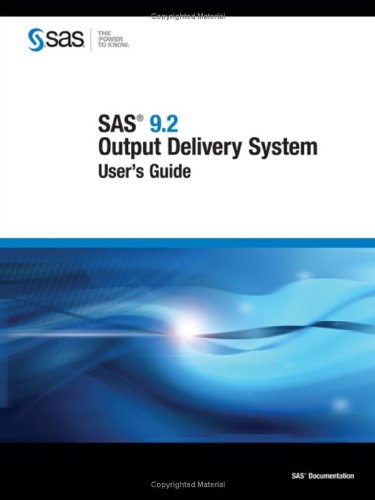

Most ebook files are in PDF format, so you can easily read them using various software such as Foxit Reader or directly on the Google Chrome browser.
Some ebook files are released by publishers in other formats such as .awz, .mobi, .epub, .fb2, etc. You may need to install specific software to read these formats on mobile/PC, such as Calibre.
Please read the tutorial at this link. https://ebooknice.com/page/post?id=faq
We offer FREE conversion to the popular formats you request; however, this may take some time. Therefore, right after payment, please email us, and we will try to provide the service as quickly as possible.
For some exceptional file formats or broken links (if any), please refrain from opening any disputes. Instead, email us first, and we will try to assist within a maximum of 6 hours.
EbookNice Team

Status:
Available4.5
17 reviews(Ebook) SAS 9.2 Output Delivery System User s Guide 1st Edition by SAS Publishing - Ebook PDF Instant Download/Delivery: 9781599945910 ,1599945916
Full download (Ebook) SAS 9.2 Output Delivery System User s Guide 1st Edition after payment

Product details:
ISBN 10: 1599945916
ISBN 13: 9781599945910
Author: SAS Publishing
Provides usage information and examples for Output Delivery System (ODS) capabilities. The document describes a wide range of formatting options and shows how to gain greater flexibility in generating, storing, and reproducing SAS procedure and DATA step output
(Ebook) SAS 9.2 Output Delivery System User s Guide 1st Edition Table of contents:
New Features and Enhancements for ODS Statements
New Features and Enhancements for the DOCUMENT Procedure
New Features and Enhancements for the TEMPLATE Procedure
New ODS Support for SAS/GRAPH
Query Open ODS Destinations
Introduction
Accessibility Features in ODS
Creating Listing Output
Creating Output in HTML Format
Producing Output in Multiple Formats Simultaneously
Where to Go from Here
Concepts
Output Delivery System: Basic Concepts
Listing Output
HTML Output
RTF Output
XML Output
Components of SAS Output
Overview of ODS Destination Categories
The SAS Formatted Destinations
The Third‑Party Formatted Destinations
Controlling formatting features of Third‑Party Formats
Understanding Styles, Style Elements, and Style Attributes
Using Styles with Base SAS Procedures
Understanding Item Stores, Template Stores, and Directories
Changing Your Default HTML Version Setting
Changing ODS Destination Default Settings
Selection and Exclusion Lists
Customized Output for an Output Object
Securing ODS-Generated PDF Files
Summary of ODS
Using ODS with the DATA Step
How ODS Works with the DATA Step
Example 1: Creating a Report with the DATA Step and Default Table Definition
Example 2: Producing ODS Output That Contains Selected Variables
Example 3: Assigning Attributes to Columns in ODS Output
Example 4: Creating and Using a User‑Defined Table Definition Template
ODS Language Statements
Global Statements
ODS Statement Category Descriptions
ODS Statements by Category
Dictionary of ODS Language Statements
The DOCUMENT Procedure
Using the DOCUMENT Procedure
Syntax: DOCUMENT Procedure
About ODS Documents
Understanding an ODS Document Path
Getting Familiar with Output Objects
ODS Documents in the Documents Window
ODS Documents in the Results Window
Comparisons: Documents Window vs. Results Window
Creating Shortcuts in the Documents Window
Comparisons: Documents Window vs. DOCUMENT Procedure
Examples: DOCUMENT Procedure
The TEMPLATE Procedure
Using the TEMPLATE Procedure
What You Can Do with the TEMPLATE Procedure
Backward Compatibility of ODS Templates
Terminology: TEMPLATE Procedure
PROC TEMPLATE Statements by Category
Syntax: TEMPLATE Procedure
Where to Go from Here
What Is a Template Store?
Template Store Syntax: TEMPLATE Procedure
Contents of SAS-Supplied Templates
Examples: Managing Template Stores with TEMPLATE Procedure
Creating a Customized Crosstabulation Table with TEMPLATE Procedure
Crosstabulation Table Template Features
Crosstabulation Table Syntax: TEMPLATE Procedure
DYNAMIC Statement
FOOTER Statement
NOTES Statement
END Statement
CELLSTYLE AS Statement
Working with CrossTabFreqs Template
Comparison: Table Templates vs. Crosstabulation Templates
Crosstabulation Table Regions and Attributes
Examples: Modifying Crosstab Output via TEMPLATE Procedure
Introduction to the Graph Template Language
STATGRAPH Syntax: TEMPLATE Procedure
Where to Go from Here
Using TEMPLATE Procedure to Create a Style
Style Features and Syntax
IMPORT Statement
REPLACE Statement
STYLE Statement
END Statement
Working with Styles
ODS Styles with Graphical Style Details
Understanding Styles, Style Elements, and Style Attributes
Understanding Inheritance
Understanding Style References
Using the FROM Option
Inheritance Compatibility Across Versions
Examples: Creating and Modifying Styles via TEMPLATE Procedure
Using TEMPLATE Procedure to Customize Tabular Output
Table Template Features
Table Template Syntax: TEMPLATE Procedure
CELLSTYLE AS, COMPUTE AS, DEFINE HEADER, DYNAMIC, MVAR, NOTES, TRANSLATE INTO, END Statements (Table Context)
Viewing Table Template Contents
Column Value Formatting and Justification
Examples: Modifying Tabular Output via TEMPLATE Procedure
Overview: ODS Tagsets & TEMPLATE Procedure
Tagset Markup Language Syntax
DEFINE EVENT, BREAK, DELSTREAM, DONE, EVAL, FLUSH, NDENT, NEXT, OPEN, PUT, PUTL, PUTLOG, PUTQ, PUTSTREAM, PUTVARS, SET, STOP, TRIGGER, UNSET, NOTES, END Statements (Tagset Context)
Getting Familiar with Tagsets
Creating Custom Tagsets
Examples: Creating & Modifying Tagsets via TEMPLATE Procedure
Appendices
Creating Sample Data Sets (various examples)
Implementing HTML Links and References
Understanding ODS HTML File Components (Body, Frame, etc.)
z/OS-Specific HTML Output Considerations
General ODS Style Elements & Graphics-Specific Style Details
Reading Recommendations
Glossary
Index
People also search for (Ebook) SAS 9.2 Output Delivery System User s Guide 1st Edition:
sas 9.4 no output destinations active
q-sys designer 9.2
sas 9.4 rand function
sas/stat 9.4 user's guide
ls ps sas
Tags: SAS Publishing, SAS 9 2, Output Delivery System